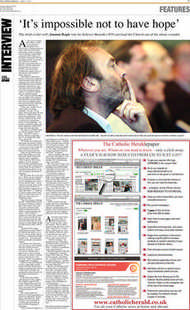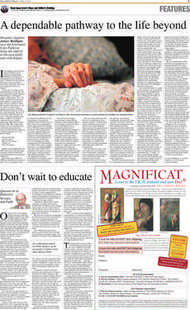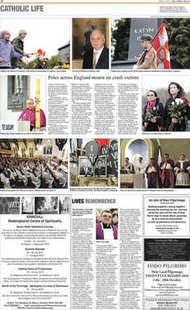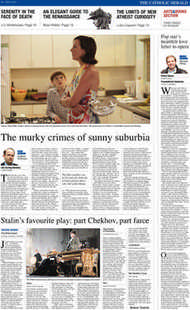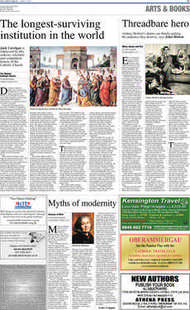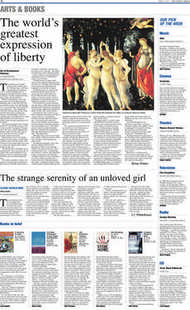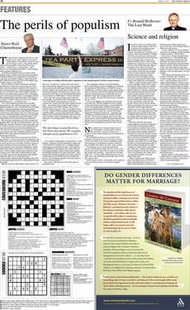Page 9, 23rd April 2010
Page 9

Report an error
Noticed an error on this page?If you've noticed an error in this article please click here to report it.
Tags
Share
Related articles
Archbishop Thanks God For Sisters
Nuns And Priests Mark 50 Years Of Service
Archbishop Honours Parishioners
Cathedral Marks Its Century
Bishop Dunn Is Buried In Cathedral
A dependable pathway to the life beyond
In his homily at the Mass in honour of Our Lady of Lourdes at Westminster Cathedral on February 13 Archbishop Vincent Nichols said: “Comfort is at the heart of the care we strive to offer to each other, especially those who are burdened by illness or distress.” This is true, of course, of all who genuinely care for the sick. The Constitution of the National Health Service, published in January 2009, states: “We – the NHS – respond with humanity and kindness to each person’s pain, distress, anxiety or need. We search for the things we can do, however small, to give comfort and relieve suffering. We find time for those we serve and work alongside. We do not want to be asked, because we care.” These are splendid sentiments, suitable as a mission statement for any Lourdes pilgrimage. High praise indeed for the NHS. But, as the Archbishop went on to indicate, this is the ideal and ideals aren’t always reached because often, as T S Eliot reminds us in “The Hollow Man”: Despite its laudable ideals, the NHS often finds itself the target of strong criticism, both from individual patients and interested collectives.
One of the areas where the NHS has recently been criticised most is for its adoption of the Liverpool Care Pathway for the dying patient. Two items in particular in the Catholic press in this country have caused quite some consternation. On September 18 2009 this paper published an article which, among other criticisms, depicted the Liverpool Care Pathway (LCP) as a heartless, box-ticking approach to the care of the dying patient, and on January 24 2010 the Universe published an article equating the LCP with euthanasia. Other media reports suggest that there is a widespread belief with many that with the LCP patients are too easily assumed to be dying, which becomes a self-fulfilling prophecy. There also appears to be quite a substantial level of public misunderstanding around clinically assisted nutrition and hydration. The LCP was developed between the Liverpool Royal Infirmary and Liverpool’s Marie Curie hospice in the late 1990s. It was developed to try to provide the same level of medical and nursing expertise at the end of life as during other treatments, wherever the location of the patient. Its main emphasis is on uniting professional, multi-discipline support in the various fields of physical treatment, in psychological support, in support for carers and in spiritual care. When the patient has been diagnosed as dying the LCP becomes the legal document that every member of the multi-discipline team works with. It has three main sections: initial assessment; ongoing assessment and care; and Care after death. Doctors realise and admit that they are not infallible in diagnosing a patient’s condition and in the crucial first stage of the pathway the multi-discipline team caring for the patient has to agree that all reversible causes for the patient’s conditions have been considered and that there is a consensus that the patient is in fact dying. The assessment then takes stock of what palliative care options to consider and whether non-essential treatments and medications should be discontinued.
But the pathway is not a oneway route, and if no deterioration of the patient's condition occurs, pathway-based palliative care is halted and all previous treatments are resumed. Currently this occurs for about three per cent of patients put on the pathway. The pathway recommends that the LPC carers regularly assess how well the patients can communicate with their families and check frequently that they understand what is happening. There is also a requirement to find out if patients’ religious and spiritual needs are being addressed. The programme also provides suggestions for treatments to manage any pain, agitation, respiratory tract secretions, nausea and vomiting, or shortness of breath that the patient may experience. Staff are preauthorised to give such interventions as are required, usually by subcutaneous injection, so that symptoms can be addressed as soon as necessary.
The LPC has an annual review by a multi-professional steering group who review the most upto-date evidence and feedback from its use. This careful review is monitored by medical professionals who include some individuals whose pro-life credentials are impeccable. The improved version 12 was issued in November 2009. The recent audit assessed that on the whole the LCP was working well. It is perhaps humbling for those of us involved in healthcare chaplaincy that the one area revealed to be not working as effectively as others turns out to be the area of religious and spiritual needs – but this no doubt reflects the difficulty of adequate chaplain provision throughout the NHS. As provision for religious and spiritual needs for the dying patient outside of the LCP is unlikely to be significantly different, it is interesting that it has taken the LCP to highlight attention to this area.
A consultation draft of a guide on the spiritual care of the dying person has been published by the Catholic Bishops’ Conference of England and Wales. It comments directly, and in a helpful fashion, on the LCP: “The Liverpool Care Pathway (LCP) provides an approach to care in the last few days of life. It does not sanction euthanasia or suicide and does not mandate any unethical actions. It aims to improve end of life care. It can be used in an ethical way. Nevertheless, the LCP is not a substitute for individual assessment, professional knowledge and skill or for virtue and moral reasoning.” The Bishop’s Conference draft guide also comments pertinently, and again helpfully, on the apparently much misunderstood issue of clinically assisted nutrition and hydration within the LCP: “While clinically assisted nutrition and hydration should generally be provided where this is the best way to address nutritional needs, this may not be indicated in the last few days of life. At this stage the nutrition will have little or no effect of prolonging life,” it states: “If there is doubt about whether clinically assisted hydration may provide some symptom relief or may marginally prolong life, then this is to be weighed against the burdens of the insertion and maintenance of drips or feeding tubes. The burdens will vary depending on the method of clinically assisted nutrition and hydration and the situation of the patient.” Both the medical profession and those with responsibility for healthcare chaplaincy have been stung by what they see as uninformed and unfair criticism of the LCP.
My own experiences of the LCP, from the perspective of hospital chaplain, have been very positive. I have certainly not found the heartless box-ticking approach allegation to have any foundation. In fact the opposite. I have been very impressed with how each patient is accorded dignity as an individual, and how much the LCP carers strive to look after often the most idiosyncratic of needs. To illustrate this, perhaps it may be useful here to recall my experience of the treatment of an 89year-old lady, a former professional musician, who died recently as a patient placed on the LCP. This lady, when placed on the LCP, although extremely weak, was lucid and coherent. She told me that she knew she was dying. She requested that she be allowed a valedictory gin and tonic with her family and asked me if I would join her. The doctor in charge of the LCP team happily agreed (Sadly, the lady died just before her brother, who was organising the gin and tonic, arrived at the hospital.) In many ways the LCP is nothing new. It is a drawing together of various strands of best practice in care of the dying. No one is saying it’s perfect, but it’s a laudable ideal. And if the ideal falls short this is not due to any intrinsic flaw in the programme, but more likely due to the T S Eliot “shadow” alluded to – to human frailty, to financial constraints and, as Archbishop Vincent Nichols put it in his Lourdes Mass homily, perhaps to the pressures of control and delivery which can impair and diminish the ability of staff to care properly.
blog comments powered by Disqus








